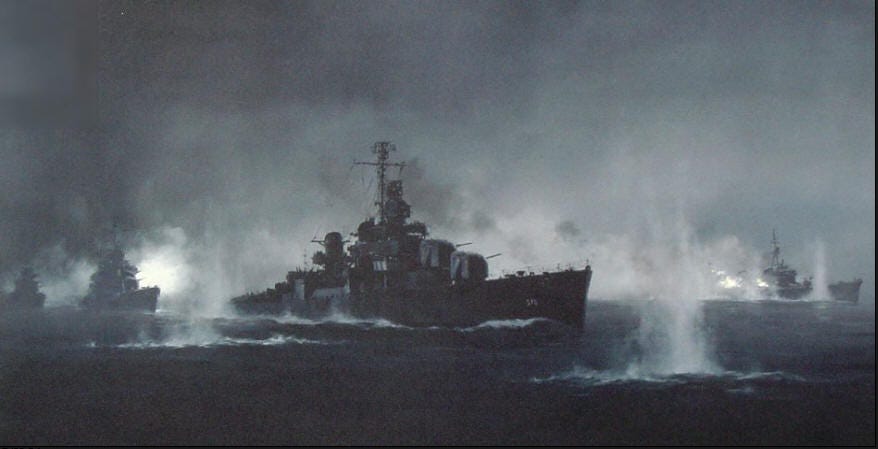Your ships are worn out and patched together after months of fighting. Your Sailors are tired. You are in the middle of refueling and resupply well away from the enemy. On the mess decks, the crew is thinking about what can be done to pick up the crew for the Thanksgiving holiday.
Then you get a message;
On the day before Thanksgiving, American Admiral William “Bull” Halsey ordered Captain Arleigh “31-Knot” Burke ... to intercept the Japanese convoy.
...
When he received Halsey’s order, Burke was hundreds of miles away, taking on fuel at New Georgia Island. The destroyers that made up his small fleet — the Charles Ausburne (Burke’s ship), Claxton, Dyson, Converse, and Spence — had been in almost continuous battles for several months and were badly in need of maintenance.
Because of that, Burke’s ship was capable of only 31 knots, not its maximum speed of 38 knots. That resulted in a message from Admiral Halsey that gave Burke his nickname:“THIRTY-ONE KNOT BURKE GET ATHWART THE BUKA-RABUAL EVACUATION LINE … IF ENEMY CONTACTED YOU KNOW WHAT TO DO.”
Burke and his task force sped north to try to find and destroy the Japanese task force. They found what they were looking for not long after midnight on Thanksgiving Day, Nov. 25, 1943, when they encountered two of the Japanese destroyers, the Makinami and the Onami.
... Using their relatively new radar technology on the moonless, dark, overcast night, Burke’s squadron fired more than a dozen torpedoes and sank both ships, finishing off one of the Japanese destroyers with surface guns.
The chase was then on to catch the fleeing destroyer-transports. Burke’s task force caught up with the Yuguri, sinking it and damaging the Uzuki, although the Uzuki managed to escape with the last Japanese ship, the Amagiri. It was the Amagiri that had collided with PT-109, the boat skippered by Lt. John F. Kennedy, on August 1, 1943.
Trying to catch the fleeing Uzuki and the Amagiri, Burke went deep into Japanese-held territory — far beyond the reach of American air cover. With the onset of dawn and the possibility of massed attacks by Japanese aircraft, Burke wisely ended the chase and withdrew.
...
Not a single American sailor was killed. Gunfire from the Japanese destroyers had all missed. A Japanese torpedo that hit one of the American destroyers didn’t explode. A group of torpedoes fired by the Japanese exploded in the wakes of Burke’s destroyers after he had a gut feeling that he should change position. And when Destroyer Squadron 23 withdrew, not a single plane from the four Japanese airbases in the vicinity of Rabaul (58 bombers and 145 fighters) attacked the task force. It was either luck or a series of miracles or a combination of both.
Burke’s strategy and tactics, and the performance of his sailors, led to the Naval War College calling the Battle of Cape St. George “an almost perfect surface action.” Bull Halsey called it the “Trafalgar of the Pacific.” It ended the Tokyo Express, the Japanese naval convoys that were used to supply Japanese land forces and attack Allied military efforts in the Solomon Islands.
Can only make 80% of your max speed due to maintenance? OK. What is your weapons state? Fine? Good. You're good to go.






Sometimes getting your whole force to the objective, albeit at a slower speed, is best move.
Sometimes, like the Mongols taught, having 10 men on the objective on time was better than having 10,000 there later.
The good commanders know the difference.
In my field, Patton was a proponent of:
" A good decision, implemented promptly with vigor, always beats the perfect course of actual, timidly executed, too late"
Hence changing the axis of advance for the 3rd Amy, and attacking 100 miles into the flank of Bastogne in the middle of Winter, in 3 days.
"Can only make 80% of your max speed due to maintenance? OK. What is your weapons state? Fine? Good. You're good to go." We still have those Sailors, just not enough of them in Senior Command.